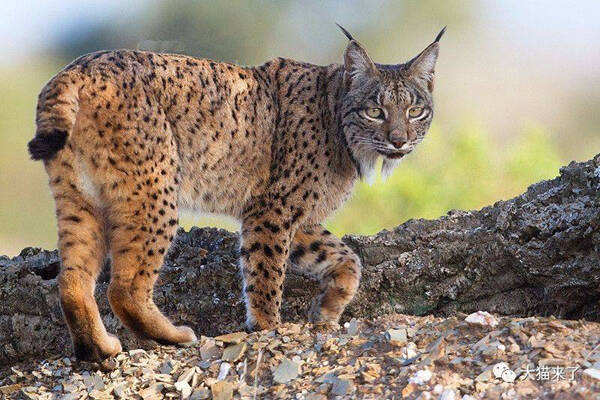Lynx pardinus
IUCN
LCBasic Information
Scientific classification
- name:Lynx pardinus
- Scientific Name:Lynx pardinus,Spanish Lynx,Marco Pseudomarginatus, Iberian Lynx, Southern European Lynx
- Outline:Carnivora
- Family:Schizopoda Felidae Lynx
Vital signs
- length:60-100cm
- Weight:5-15kg
- lifetime:About 13 years
Feature
Smaller than the common lynx, with darker spots on its fur
Distribution and Habitat
The Spanish lynx is found on the Iberian Peninsula in southwestern Europe, mainly in the mountainous forests of Spain and Portugal, with a large number in the Coto Donana National Park in Spain.
The Spanish lynx prefers habitats with different shapes, including dense shrubs, mixed shrubs such as raspberry, frankincense and juniper, as well as trees such as holly oak, Spanish cork oak, and a variety of trees such as oak, open grassland. It is mainly distributed in vegetated mountainous areas or short shrub forests.
Appearance
The Spanish lynx is 60-100 cm long, with a tail length of 5-19 cm, a shoulder height of 40-50 cm, and a weight of 5-15 kg. Males are larger than females. They have distinct leopard-like spots on their bodies, and their fur is bright yellow-red to yellow-brown, covered with brown or black spots, with white underparts. The Spanish lynx is very similar to the Eurasian lynx in appearance, except that it is smaller (usually only half the weight of the Eurasian lynx), lighter in color, and darker in spots. The tail is thick and black at the end. There is a tuft of black hair on the tip of the ear, the antennae, and the temples. The Spanish lynx has long legs and a short tail, and a circle of bead-like hair on its face. The ears are erect and covered with black hair. Compared with the dark-marked Eurasian lynx, it has very obvious spots on its body, which makes it look more like a leopard. However, its face is more cat-like than other lynxes.
The hair on the Spanish lynx's ears helps
Details
The Spanish lynx (scientific name: Lynx pardinus) is the largest cat species in Europe. It is considered by biologists to be one of the smallest cat species in the world, with no subspecies.

Spanish lynx, especially females with cubs, roam as far as 100 kilometers. Depending on the amount of prey, they need a territory of 10-20 square kilometers. They mark the boundaries of their territory with urine, feces or claw marks on tree bark. The male's territory is clearly demarcated, while the female's territory often overlaps with that of the male, and sometimes a male's territory overlaps with that of several females.
The Spanish lynx lives alone and hunts alone. It hunts in the dim light of the day, sneaking up on its prey, or lying in wait for hours behind a water hole or a rock until the prey is only a few steps away before it pounces on it.
The Spanish lynx mainly preys on small mammals, including birds, small reptiles and amphibians. Hares are their "staple food", accounting for as much as 80% of their total food. Male Spanish lynx eats one hare a day, while females in the breeding period need to eat three rabbits a day. As the number of Spanish hares has declined, the Spanish lynx has had to start hunting other animals, such as young deer, roe deer and antelope.
Female Spanish lynx leave their territory to search for males during the breeding season. The gestation period is usually two months, and the birth period is between March and September, with the peak of fertility in March and April. A litter usually contains 2 to 3 cubs (occasionally 1, 4 or 5), each weighing 200–250 grams. The young lynx can become independent at seven to ten months old, but usually stay with the mother until the age of twenty months. The survival rate of the cubs depends on the availability of prey. In the wild, both sexes reach sexual maturity at one year old, but rarely reproduce before finding a territory without other lynx. There have been female lynxes that began to reproduce after the mother died at the age of five. The maximum lifespan in the wild is 13 years.
The Spanish lynx is the most threatened cat in the world and the most endangered carnivore in Europe. According to a 1990 survey by the World Conservation Union, the Spanish lynx may become extinct by 2011. A 2000 survey found that there were only 400 Spanish lynx left, and by 2005, the number had dropped to about 100. The number of Spanish lynx dropped by 80% between the 1960s and 1980s.
The main threats to the survival of the Spanish lynx come from the loss of habitat and the lack of prey. Sometimes they are hit and killed by passing cars on the road or fall into traps. A mucopox virus has caused a sharp decline in the number of European rabbits, almost to extinction, which has serious implications for the survival of the Spanish lynx.
The Spanish government has cancelled plans to build a 300-kilometer highway through the country's plains. This is to protect the Spanish lynx, one of the world's most endangered species, from the threat to its survival. The "EU (EU) Natura 2000 Project" is the most intensive conservation project in Europe. WWF calls on "Natura 2000" to protect all habitats of the lynx. People hope that this discovery will revive the action to save the world's most endangered cat in Spain.
Listed in the 2008 Red List of Endangered Species of the World Conservation Union (IUCN) ver 3.1 - Critically Endangered (CR).
Listed as a Class I protected animal in the Washington Convention.
Protect wild animals and stop eating game.
Maintaining ecological balance is everyone's responsibility!








